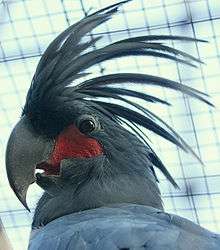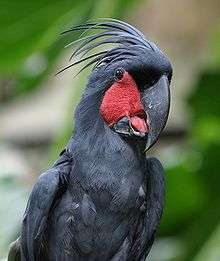Palm cockatoo
| Palm cockatoo | |
|---|---|
 | |
| At Melaka Zoo, Malaysia | |
| Scientific classification | |
| Kingdom: | Animalia |
| Phylum: | Chordata |
| Class: | Aves |
| Order: | Psittaciformes |
| Superfamily: | Cacatuoidea |
| Family: | Cacatuidae |
| Subfamily: | Cacatuinae |
| Tribe: | Microglossini |
| Genus: | Probosciger Kuhl, 1820 |
| Species: | P. aterrimus |
| Binomial name | |
| Probosciger aterrimus (Gmelin, 1788) | |
| Subspecies | |
|
P. a. aterrimus | |
 | |
| Australian palm cockatoo range (in green) | |


The palm cockatoo (Probosciger aterrimus), also known as the goliath cockatoo or great black cockatoo, is a large smoky-grey or black parrot of the cockatoo family native to New Guinea, Aru Islands and Cape York Peninsula. It has a very large black beak and prominent red cheek patches.
Taxonomy
The palm cockatoo was originally described by German naturalist Gmelin in 1788. Its specific name, Probosciger aterrimus, is from Latin proboscis, long thin nose + -ger, carry and Latin superlative adjective for ater, black, hence a "black [bird] with a long thin nose (beak)".
It is the only member of the subfamily Microglossinae and the only member of the monotypic genus, Probosciger. Its unique position within the cockatoo family has been confirmed by molecular studies. It is the earliest offshoot from the ancestors of what have become the cockatoo family.[2]
There are three poorly differentiated subspecies, and one distinctive subspecies: Cape York cockatoo (P. a. aterrimus[Gmelin 1788]), the larger goliath cockatoo (P. a. goliath[Kuhl 1820]), Northern palm cockatoo (P. a. stenolophus[van Ort 1911]) similar to goliath but crest feathers much narrower, and P. a. macgillivrayi[Mathews 1927] intermediate in size.[3]
The species was named the "Goliath Aratoo" in Wood's Natural History (1862). It is also sometimes given the misnomer "black macaw" in aviculture - the macaws are unrelated New World parrots. Confusingly, this name was also used by early naturalists and Brazilian natives to refer to the dark blue hyacinth macaw.
Description
The palm cockatoo is 55 to 60 cm (22 to 24 in) in length and weighs 910–1,200 g (2.01–2.65 lb).[4] It may be the largest cockatoo species and largest parrot in Australia, although large races of yellow-tailed black cockatoos and sulphur-crested cockatoos broadly overlap in size. It is a distinctive bird with a large crest and has one of the largest bills of any parrot (only the hyacinth macaw's is larger). This powerful bill enables palm cockatoos not only to eat very hard nuts and seeds, but it also enables males to break off thick (~1") sticks from live trees to use for a drumming display (Wood 1984). The male has a larger beak than the female.[4] The bill is unusual as the lower and upper mandibles do not meet for much of its length, allowing the tongue to hold a nut against the top mandible while the lower mandible works to open it. The palm cockatoo also has a distinctive red cheek patch that changes colour when the bird is alarmed or excited.
The palm cockatoo has a large and complex vocal repertoire, including many whistles and even a "hello" call that sounds surprisingly human-like. There are distinct dialects throughout the species' range.
There is anecdotal evidence of a palm cockatoo reaching 80 or 90 years of age in an Australian zoo,[5] although the oldest confirmed individual was aged 56 in London Zoo in 2000.[6] Although longevity of captive birds is known, it is still unknown how long palm cockatoos live in the wild.
Distribution and habitat
The palm cockatoo is distributed in rainforests and woodlands of New Guinea and Cape York Peninsula Queensland, Australia. It can still be found near Sorong, West Papua, Indonesia, where it is sometimes seen in trees along the roads.[7]
Behavior

It has a unique territorial display where the bird (typically the male) drums with a large (i.e. up to 1" diameter, 15 cm long) stick or seed-pod against a dead bough or tree, creating a loud noise that can be heard up to 100 m away.[8] After drumming, the male occasionally strips the drum-tool into small pieces to line the nest.. Although this drumming behaviour was discovered over two decades ago (in 1984 by G.A. Wood), the reason why palm cockatoos drum is still a mystery. One reason could be that females can assess the durability of the nesting hollow by the resonance of the drumming. Another possibility could be that males drum to mark their territory against other males. The palm cockatoo is an unusual bird, being an ancient species and one of the few bird species known to use tools.[7]
Vocalization
The vocalizations of palm cockatoos are similar to those of most wild parrots, but they have also been shown to produce a variety of additional syllables in display and exchange with neighbouring individuals. These additional syllables are mainly produced by males and are often combined to form long, complex sequences. In a population in the Iron Range, thirty different syllables were distinguished.[9]
Flocking
This species normally does not appear in large numbers. They are not known to flock feed like many of the cockatoo species. Usually only one to six individuals will be observed feeding together at one time. As with other large birds both parents care for young so seeing a breeding pair is not unusual. If these birds do congregate it will usually happen in open woodland just after sunrise or along the rainforest edge before returning to individual roost for the night.[10]
Breeding
Palm cockatoos only lay one egg every second year and have one of the lowest breeding success rates reported for any species of parrot.[5] Off-setting this is their very long life-span. A male commenced breeding at 29 in Taronga Zoo in Sydney, and a female at the London Zoo was 40 when she laid her first egg in 1966. Breeding takes place inside tree hollows that look like standing pipes. Fires play an important role in the destruction and creation of nest hollows. Fires allow the colonisation of microorganisms and termites, which enter the tree and start hollowing out the inside. Cyclones are important in the final stage of nest hollow development.
Diet
The palm cockatoo is often feeding during in the early hours of the day on a diet that consists mostly of wild growing pandanus palm fruit and nuts from the Kanari tree, Canarium australasicum. They have also been seen eating fruit from Darwin stringy bark Eucalyptus tetradonta and nonda tree as well as seeds from the cocky apple tree, beach almond and black bean tree.[10]
Conservation and status
The palm cockatoo is still relatively common in Cape York, but is threatened there by habitat destruction, particularly due to bauxite mining around Weipa and altered fire regimes elsewhere. Palm cockatoos are hunted in New Guinea. The palm cockatoo is currently evaluated as Least Concern on the IUCN Red List of Threatened Species. It is listed on Appendix I of CITES. In Australia, Palm Cockatoos were up-listed from Near Threatened to Vulnerable on 31 October 2015 (EPBC Act List of Threatened Fauna).
Aviculture
This species is in high demand for the pet trade due to its unusual appearance.
In early captive situations pet owners would either feed dog kibble or generic bird seed mixture while zoos would give them "monkey biscuits". As their nutritional needs became more apparent over the years owners have shifted to specially formulated "manufactured diet" pellets along with a wide variety of treats like peanuts, pecans, Brazil nuts, pine nuts, sunflower seeds, oranges, apples, grapes, pomegranate, bananas, sweet potatoes, carrots, beets, broccoli and kale. Many zoos will still give them monkey biscuits to broaden their diet.[11]
See also
- Calyptorhynchus, a genus of large black cockatoos
- Black parrot or lesser Vasa parrot, an unrelated species of large black parrot from Madagascar
- Australian raven, an unrelated passerine bird, that is also large and black
References
- ↑ BirdLife International (2012). "Probosciger aterrimus". IUCN Red List of Threatened Species. Version 2013.2. International Union for Conservation of Nature. Retrieved 26 November 2013.
- ↑ Brown DM, Toft CA (1999). "Molecular systematics and biogeography of the cockatoos (Psittaciformes: Cacatuidae)". Auk. 116 (1): 141–57. doi:10.2307/4089461. ISSN 0004-8038.
- ↑ Shodde & Mason (1997). Aves(Columbidae to Coraciidae) in Zoological Catalogue of Australia 37.2. p. 74.
- 1 2 Forshaw, Joseph M. (2006). Parrots of the World; an Identification Guide. Illustrated by Frank Knight. Princeton University Press. ISBN 0-691-09251-6.
- 1 2 Murphy S, Legge S, Heinsohn R (2003). "The breeding biology of palm cockatoos (Probosciger aterrimus): a case of a slow life history". Journal of Zoology. 261: 327–39. doi:10.1017/S0952836903004175.
- ↑ Brouwer K, Jones M, King C, Schifter H (2000). "Longevity records for Psittaciformes in captivity". International Zoo Yearbook. 37: 299–316. doi:10.1111/j.1748-1090.2000.tb00735.x.
- 1 2 Indonesian Parrot Project
- ↑ Australian Geographic
- ↑ Zdenek, C.N.; Heinsohn, R.; Langmore, N.E. (2015). "Vocal complexity in the palm cockatoo (Probosciger aterrimus)". Bioacoustics. 24 (3): 253–257. doi:10.1080/09524622.2015.1070281.
- 1 2 Parrot Tag: Palm Cockatoo
- ↑ Nutritional Requirements of Adult Palm Cockatoos
Further reading
- Murphy, S.A.; Double, M.C.; Legge, S.M. (2007). "The phylogeography of palm cockatoos, Probosciger aterrimus, in the dynamic Australo-Papuan region". Journal of Biogeography. 34: 1534–1545. doi:10.1111/j.1365-2699.2007.01706.x.
- Murphy, S.A.; Legge, S.M. (2007). "The gradual loss and episodic creation of Palm Cockatoo (Probosciger aterrimus) nest-trees in a fire- and cyclone-prone habitat". Emu. 107: 1–6. doi:10.1071/mu06012.
External links
| Wikimedia Commons has media related to Probosciger aterrimus. |
- BirdLife Species Factsheet
- The Palm Cockatoo Research Project.
- Royal Society for the Protection of Birds (RSPB) website – Threats to wild bird populations
- CITES website search page
- Oriental Bird Images: palm cockatoo Selected photos
